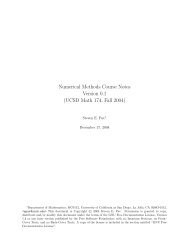Integral representations and integral transforms of some families of ...
Integral representations and integral transforms of some families of ...
Integral representations and integral transforms of some families of ...
Create successful ePaper yourself
Turn your PDF publications into a flip-book with our unique Google optimized e-Paper software.
4 N. Elezović et al.<br />
151<br />
152<br />
153<br />
154<br />
155<br />
156<br />
157<br />
158<br />
159<br />
160<br />
161<br />
162<br />
163<br />
164<br />
165<br />
166<br />
167<br />
168<br />
169<br />
170<br />
171<br />
172<br />
173<br />
174<br />
175<br />
176<br />
177<br />
178<br />
179<br />
180<br />
181<br />
182<br />
183<br />
184<br />
185<br />
186<br />
187<br />
188<br />
189<br />
190<br />
191<br />
192<br />
193<br />
194<br />
195<br />
196<br />
197<br />
198<br />
199<br />
200<br />
Using the same procedure as described above, each <strong>of</strong> the following two Laplace <strong>transforms</strong><br />
can be derived:<br />
L(S μ<br />
(α,0) (r;{k 2/α }))(x) = 2√ ∫<br />
π ∞<br />
t μ−1/2 (∫ ∞<br />
e −xr<br />
)<br />
Ɣ(μ) 0 e t − 1 0 (2r) J μ−1/2(rt)dr dt<br />
μ−1/2<br />
2 √ ∫<br />
π ∞<br />
t μ−1/2 (∫ ∞<br />
)<br />
=<br />
e −xr r 1/2−μ J<br />
2 μ−1/2 Ɣ(μ) 0 e t μ−1/2 (rt)dr dt<br />
− 1 0<br />
∫<br />
2 ∞<br />
t 2μ−1 (<br />
=<br />
xƔ(2μ) 0 e t − 1 2 F 1 1, 1 2 ; μ + 1 2 )<br />
2 ;−t dt (15)<br />
x 2<br />
<strong>and</strong><br />
∫<br />
L( ˜S μ (α,0) (r;{k 2/α 2 ∞<br />
t 2μ−1 (<br />
}))(x) =<br />
xƔ(2μ) 0 e t + 1 2 F 1 1, 1 2 ; μ + 1 2 )<br />
2 ;−t dt, (16)<br />
x 2<br />
where ˜S μ<br />
(α,0) (r;{k 2/α }) is the alternating version <strong>of</strong> S μ (α,0) (r;{k 2/α }).<br />
III. We next recall the following <strong>integral</strong> representation from the work <strong>of</strong> Srivastava <strong>and</strong><br />
Tomovski [15]:<br />
S (α,β)<br />
μ (r;{k q/α }) =<br />
2<br />
Ɣ (q [μ − β/α])<br />
· 1F q<br />
[μ; <br />
∫ ∞<br />
x q(μ−β/α)−1<br />
0 e x − 1<br />
(<br />
q; q<br />
[<br />
μ − β α<br />
])<br />
;−r 2 ( x<br />
q<br />
where, for convenience, (q; λ) abbreviates the array <strong>of</strong> q parameters:<br />
λ<br />
q , λ + 1 ,..., λ + q − 1<br />
q<br />
q<br />
For q = 2, we find from (17) that<br />
S (α,β)<br />
μ (r;{k 2/α }) =<br />
(q ∈ N).<br />
∫<br />
2<br />
∞<br />
x 2(μ−β/α)−1<br />
Ɣ (2 [μ − β/α]) 0 e x − 1<br />
(<br />
· 1F 2 μ; μ − β α ,μ− β α + 1 x 2<br />
2 ;−r2 4<br />
(<br />
r, α, β ∈ R + ; μ − β α > 1 )<br />
.<br />
2<br />
) q ]<br />
dx, (17)<br />
)<br />
dx (18)<br />
The following hypergeometric <strong>integral</strong> formula involving the Laplace–Mellin transform is<br />
well-known (see, for example, [7, p. 60]):<br />
(<br />
p+2F q σ, σ + 1 ) ∫ ∞<br />
2 ,α p; β q ;− 4ω2 = zσ<br />
e −zt t σ −1 (<br />
pF<br />
z 2 q αp ; β q ;−ω 2 t 2) dt (19)<br />
Ɣ(σ)<br />
(<br />
R(σ ) > 0; z ̸= 0; p ≦ q − 2; |arg(z)| < π 2<br />
which, for σ = 1, yields the special case given below:<br />
(<br />
p+2F q 1, 3 ) ∫ ∞<br />
2 ,α p; β q ;− 4ω2 = z e −zt (<br />
pF<br />
z 2 q αp ; β q ;−ω 2 t 2) dt (20)<br />
0<br />
(<br />
z ̸= 0; p ≦ q − 2; |arg(z)| < π )<br />
,<br />
2<br />
0<br />
)<br />
,














